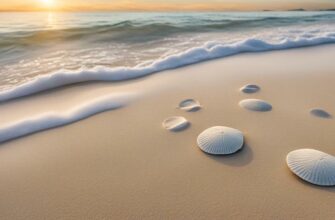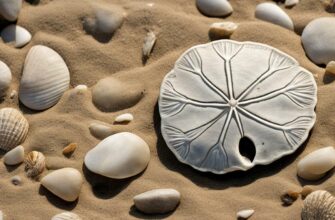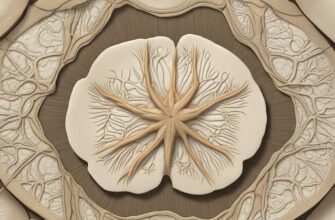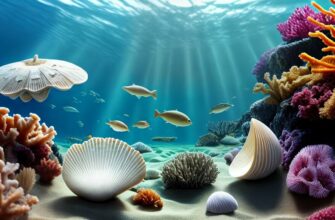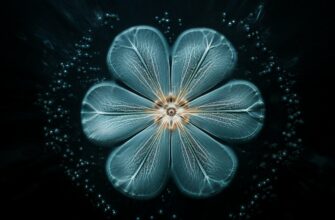Have you ever wondered about how sand dollars reproduce? Sand dollars, like all echinoderms, have an interesting and unique reproductive cycle. In this article, we will explore the different stages of the sand dollar’s life cycle, from growth and maturation to larval development, settlement, and reproductive maturity. From external fertilization to larval dispersal, we will take a closer look at the fascinating process of sand dollar reproduction and the environmental factors that can impact it.
So, let’s dive right in and explore the wonder of sand dollar reproduction!
- Life Cycle of Sand Dollars
- External Fertilization
- Spawning Behavior
- Fertilization Process
- External Fertilization
- Spawning Behavior
- Fertilization Process
- Development of Larvae
- Larval Dispersal
- Settlement and Metamorphosis
- Factors Affecting Settlement and Metamorphosis
- Growth and Reproduction
- Environmental Factors
- FAQs about Sand Dollar Reproduction
- How often do sand dollars reproduce?
- Do sand dollars reproduce sexually or asexually?
- How do sand dollars mate?
- How long does it take for sand dollar larvae to develop?
- How do sand dollar larvae disperse?
- When do sand dollar larvae settle and undergo metamorphosis?
- At what age do sand dollars become reproductive?
- What factors can affect sand dollar reproduction?
- Do sand dollars have any predators during their reproductive cycle?
Life Cycle of Sand Dollars
Sand dollars have a fascinating life cycle that includes several distinct stages. Like other echinoderms, such as sea urchins and sea stars, they undergo a process called indirect development, which means they go through a larval stage before becoming adults.
| Stage | Description |
|---|---|
| Egg | The first stage of a sand dollar’s life cycle begins with a fertilized egg. The egg is small, round, and surrounded by a protective membrane. |
| Larva | After the egg is fertilized, it develops into a larva. The larva is planktonic, which means it drifts freely in the water. It has two bands of cilia, or hair-like structures, that it uses to swim and feed on plankton. |
| Metamorphosis | As the larva matures, it undergoes metamorphosis to become a juvenile sand dollar. During this process, the larva settles on the ocean floor and undergoes a dramatic transformation to become a bottom-dwelling filter feeder. |
| Adult | Once the sand dollar reaches maturity, it becomes an adult and begins to reproduce. Adults are round and flat, with a distinctive five-pointed star shape on their bodies. |
External Fertilization
Like most echinoderms, sand dollars reproduce through external fertilization. This means that eggs and sperm are released into the water, where they combine to form larvae.
During spawning, male and female sand dollars gather in groups and release their gametes into the water simultaneously. The fertilized eggs then develop into free-swimming larvae.
Spawning Behavior
Sand dollars exhibit interesting behavior during spawning. They often aggregate in groups, which may increase their chances of successful fertilization. Some species of sand dollars also have the ability to synchronize their spawning with the lunar cycle, releasing their gametes during specific phases of the moon.
Fertilization Process
Once the eggs and sperm are released into the water, fertilization occurs. The sperm swim towards the eggs, and when they meet, a sperm and an egg combine to form a zygote. The zygote then develops into a larva, which eventually settles on the ocean floor and undergoes metamorphosis.
External Fertilization
Sand dollars reproduce through external fertilization, also known as broadcast spawning. This process involves the release of eggs and sperm into the water for fertilization to occur.
During the summer months, mature sand dollars will gather in large groups, known as aggregations, for spawning. The females will release their eggs, which are then fertilized by the sperm released by the males.
Once the eggs and sperm have combined, they form zygotes, which develop into embryos that will eventually become larvae. The larvae are then carried away by ocean currents to settle in new locations.
Spawning Behavior
During spawning season, sand dollars exhibit interesting reproductive behavior. They aggregate in large groups and release their gametes into the water. The exact timing of spawning varies depending on the species and location.
It is believed that sand dollars are able to synchronize their spawning based on environmental cues such as water temperature and tides. In some cases, they may also release their gametes in response to other individuals in the same area spawning.
Male and female sand dollars release their gametes simultaneously into the water. This external fertilization allows for the eggs to be fertilized by sperm from multiple individuals, increasing genetic diversity within the population.
Once fertilized, the eggs form into zygotes and begin to develop into embryos. The embryos eventually hatch into larvae, which will then disperse and settle onto the ocean floor to develop into juvenile sand dollars.
The spawning behavior of sand dollars is just one fascinating aspect of their reproductive cycle.
Fertilization Process
After being released into the water, sand dollar eggs and sperm will meet and fertilization will occur. This process typically takes place in the open ocean, where water currents can help disperse the gametes.
Once the eggs are fertilized, they will develop into zygotes, which are single-celled organisms with both maternal and paternal DNA. These zygotes will then begin to divide and form into embryos.
The embryonic development of sand dollars can take several days to a week, depending on water temperature and other environmental factors. During this time, the embryos will develop into larvae and acquire cilia to help them swim.
Did you know? Sand dollar sperm is often bright pink or purple in color, while the eggs are yellowish or orange.
Development of Larvae
Sand dollar larvae go through several stages of development before becoming juvenile sand dollars. The early stages of development occur in the water, where the larvae are at the mercy of ocean currents and other environmental factors.
After fertilization, the eggs hatch into small, free-swimming larvae called blastulae. These larvae are symmetrical and have cilia that allow them to move through the water. The blastulae then develop into gastrulae, which have a digestive system and a mouth. The larvae continue to feed and grow until they reach a stage called the pluteus.
| Larval Stage | Description |
|---|---|
| Blastula | Small, symmetrical, and free-swimming larvae with cilia |
| Gastrula | Larvae with a digestive system and a mouth |
| Pluteus | Larvae with arms, spines, and a bumpy appearance |
The pluteus stage is characterized by the development of arms and spines, which give the larvae a bumpy appearance. The pluteus larvae can swim and feed more efficiently than earlier stages and are able to respond to light and gravity. The larvae continue to mature until they reach the next stage, known as the brachiolaria.
During the brachiolaria stage, the larvae develop small arms that they use to crawl along the ocean floor. The larvae also begin to secrete calcium carbonate, which forms a protective covering called the test. The brachiolaria larvae continue to grow and mature until they are ready to settle on the ocean floor and undergo metamorphosis into juvenile sand dollars.
The development of sand dollar larvae is heavily influenced by environmental factors, including temperature, food availability, and water quality. Any changes in these factors can affect the growth and survival of the larvae, making them vulnerable to predation and other environmental pressures.
Larval Dispersal
After fertilization, sand dollar eggs develop into larvae that are transported by ocean currents. Sand dollar larvae have a unique ability to swim by using their cilia to move through the water column. They also have a sensory organ that helps them navigate towards suitable settlement sites.
The duration and distance of larval dispersal may vary depending on environmental factors such as temperature and ocean currents. In some cases, larvae may settle within a few days, while in other cases, they may remain in the water column for several weeks.
During this time, larvae undergo several stages and transformations as they adapt to their new environment. They develop spines and arms, which aid in attachment and burrowing into the substrate. Once they find a suitable location, the larvae attach themselves to the substrate and undergo metamorphosis, transforming into juvenile sand dollars.
Settlement and Metamorphosis
After the sand dollar larvae disperse and drift with ocean currents, they eventually settle on the ocean floor where they undergo metamorphosis to become juvenile sand dollars. Settlement usually occurs within a few days to a week after hatching, and it is a critical stage in the sand dollar life cycle.
During settlement, the larvae undergo significant changes. They develop a mouth and anus, and their body shape begins to resemble that of a miniature sand dollar. They also grow their skeleton, which forms the familiar sand dollar shape.
| Stage | Description |
|---|---|
| Early juveniles | The first stage of juveniles, recognizable by their small size and incomplete calcification of their skeleton. |
| Intermediate juveniles | Juveniles that have grown to a larger size and have a more developed skeleton. |
| Late juveniles | Fully developed juveniles with a complete skeleton and the ability to burrow into the sand. |
As the juvenile sand dollars grow, they become more robust and begin to feed on the small organisms that live on the ocean floor. They continue to grow and mature, eventually reaching reproductive maturity themselves.
Factors Affecting Settlement and Metamorphosis
The settlement and metamorphosis of sand dollar larvae can be influenced by a number of environmental factors. For example, the temperature, salinity, and quality of the water can play a significant role. Research has shown that larvae are more likely to settle and undergo metamorphosis under conditions of the same temperature and salinity as their parent population.
Additionally, the availability of food can also impact the settlement process. Larvae need sufficient food to undergo metamorphosis and grow into juvenile sand dollars. If food is scarce, it can delay or prevent the settlement and metamorphosis of larvae.
Growth and Reproduction
Sand dollars take several years to reach reproductive maturity. The process of growth and reproduction in sand dollars is influenced by several factors, including age, food availability, and water temperature.
Most sand dollars reach reproductive maturity within 2-4 years, depending on their environment. During this period, they undergo rapid growth and develop the necessary reproductive organs for reproduction.
| Factor | Impact on growth and reproduction |
|---|---|
| Food availability | Sand dollars require a steady supply of food to maintain growth and reproduction. A lack of food can lead to stunted growth and delayed maturity. |
| Water temperature | Water temperature can also affect the growth and reproduction of sand dollars. Warmer waters can lead to faster growth rates and earlier maturity, while colder waters can slow down growth and delay maturity. |
Once sand dollars reach reproductive maturity, they can mate and produce offspring. Female sand dollars release eggs into the water, while males release sperm. Fertilization occurs externally and the resulting larvae develop and undergo metamorphosis before settling on the ocean floor and beginning their growth process.
Overall, the growth and reproduction of sand dollars is a complex process that is influenced by various environmental factors. Understanding these factors can help us better protect and conserve these fascinating creatures in the wild.
Environmental Factors
While sand dollars have a relatively simple reproductive process, there are a variety of environmental factors that can impact their ability to reproduce successfully. Here are some of the most influential factors:
| Factor | Impact on Reproduction |
|---|---|
| Water temperature | Warm water temperatures can accelerate the reproductive cycle, but excessively high or low temperatures can negatively affect the process. |
| Food availability | Female sand dollars require adequate food resources to produce viable eggs, and males need sufficient nutrients to produce sperm. |
| Water quality | Poor water quality, including pollution or low oxygen levels, can harm the health and survival of sand dollar larvae. |
| Predation | Predators such as fish and crabs can reduce the number of sand dollars that survive to reproductive maturity. |
Other factors that can impact sand dollar reproduction include wave action, sedimentation rates, and the presence of predators or competitors in the habitat. These influences can vary depending on the specific geographic location where sand dollars are found.
FAQs about Sand Dollar Reproduction
Here are some common questions about the reproduction of sand dollars:
How often do sand dollars reproduce?
Sand dollars typically reproduce once a year during the spring or summer months.
Do sand dollars reproduce sexually or asexually?
Sand dollars reproduce sexually through external fertilization.
How do sand dollars mate?
Sand dollars release their eggs and sperm into the water during spawning to fertilize each other’s gametes.
How long does it take for sand dollar larvae to develop?
The development of sand dollar larvae varies depending on species and environmental conditions, but can take anywhere from a few weeks to several months.
How do sand dollar larvae disperse?
Sand dollar larvae disperse through ocean currents and their ability to swim.
When do sand dollar larvae settle and undergo metamorphosis?
After their journey through the ocean, sand dollar larvae settle on the ocean floor and undergo metamorphosis to become juvenile sand dollars.
At what age do sand dollars become reproductive?
Sand dollars typically become reproductive at around 2-3 years of age.
What factors can affect sand dollar reproduction?
Environmental factors such as temperature, food availability, and water quality can impact sand dollar reproduction.
Do sand dollars have any predators during their reproductive cycle?
Yes, sand dollar eggs and larvae are often preyed upon by various marine organisms such as crabs and fish.
These are just a few of the many questions that arise when discussing the reproduction of sand dollars. As scientists continue to study these fascinating creatures, we can expect to learn even more about the intricacies of their reproductive cycle.





